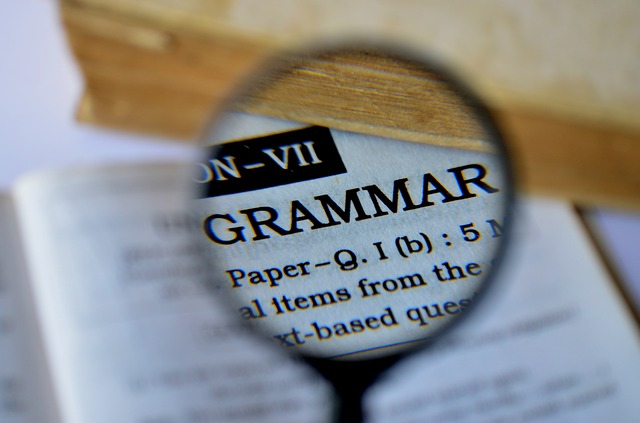Grammar Spotlight
 The English Grammar Profile (EGP) is a sister resource to the English Vocabulary Profile, and has been put together by Anne O'Keeffe (Limerick University) and Geraldine Mark, the co-authors, along with Ron Carter and Mike McCarthy, of English Grammar Today (Cambridge University Press). Mark and O'Keeffe investigated the extensive data in the Cambridge Learner Corpus to establish when learners begin to get to grips with different linguistic structures.
The English Grammar Profile (EGP) is a sister resource to the English Vocabulary Profile, and has been put together by Anne O'Keeffe (Limerick University) and Geraldine Mark, the co-authors, along with Ron Carter and Mike McCarthy, of English Grammar Today (Cambridge University Press). Mark and O'Keeffe investigated the extensive data in the Cambridge Learner Corpus to establish when learners begin to get to grips with different linguistic structures.
A series of insights from their research will be posted on this page, each one putting the spotlight on an interesting aspect of learner grammar development. Please note that all of the learner examples come from the Cambridge Learner Corpus, a 55-million word electronic collection of written learner data. The examination and the candidate’s first language are given in brackets after each learner example.
See the latest Grammar Spotlight entry below. Scroll right down to the bottom of this page to browse through previous entries.
Comparative adjectives are not widely used by learners until they reach the A2 level, at which point they can use comparative adjectives in a wide variety of contexts. They can use them with than to compare two nouns or noun phrases; attributively before nouns and as a complement of be.
 My new mobile is more interesting than my old mobile. (Cambridge English: Key; Spanish - European)
My new mobile is more interesting than my old mobile. (Cambridge English: Key; Spanish - European)
 I just watched a cricket match with my younger brother and my father. (Cambridge English: Key; Hindi)
I just watched a cricket match with my younger brother and my father. (Cambridge English: Key; Hindi)
 You can come by bus, it’s easier. (Cambridge English: Key; Turkish)
You can come by bus, it’s easier. (Cambridge English: Key; Turkish)
Learners at the A2 level confidently form comparative adjectives by adding –er.
 I played computer games with my older brother. (Cambridge English: Key for Schools; Vietnamese)
I played computer games with my older brother. (Cambridge English: Key for Schools; Vietnamese) The shirt was cheaper than the trousers. (Cambridge English: Key; Spanish)
The shirt was cheaper than the trousers. (Cambridge English: Key; Spanish)
 It is easy to use and it is smaller than the old one. (Cambridge English: Key; Spanish)
It is easy to use and it is smaller than the old one. (Cambridge English: Key; Spanish)
Learners demonstrate an understanding of basic spelling rules as they form comparative adjectives. For example, with two syllable adjectives that end in -y, learners can change the y to an i and add -er. Learners can also double the final consonant and add –er to one syllable adjectives containing a short vowel and can add only –r for one syllable adjectives ending in e.
 I like because it’s small and easier to use than other phones. (Cambridge English: Key; Spanish)
I like because it’s small and easier to use than other phones. (Cambridge English: Key; Spanish)
 I bought lots of T-shirts because the weather is getting hotter. (Cambridge English: Key; Chinese)
I bought lots of T-shirts because the weather is getting hotter. (Cambridge English: Key; Chinese)
 You can come by boat, but I prefer to come by aeroplane because it is safer. (Cambridge English: Key; Greek)
You can come by boat, but I prefer to come by aeroplane because it is safer. (Cambridge English: Key; Greek)
Learners at the A2 level demonstrate knowledge of the irregular comparative adjective better. Surprisingly, worse is not frequently used until the B1 level. The irregular comparative adjective further also emerges at the A2 level but only as a collocate of information. Once the B1 level is achieved, further is used more frequently and in a wider variety of contexts.
 This house is much better than my last house. (Cambridge English: Key; Russian)
This house is much better than my last house. (Cambridge English: Key; Russian)
 What colour do you think is better? (Cambridge English: Key; Spanish)
What colour do you think is better? (Cambridge English: Key; Spanish)
 For further information, contact Joey Hung. (Cambridge English: Key; Chinese)
For further information, contact Joey Hung. (Cambridge English: Key; Chinese)
Similar to how learners at the A2 level use better but not worse, they can form a range of comparative adjective phrases using more + longer adjective (usually of three or more syllables) but don’t often use less. It is not until the B1 level that less + longer adjective appears frequently in learner work.
 I think you must be more careful. (Cambridge English: Key; Turkish)
I think you must be more careful. (Cambridge English: Key; Turkish)
 It was more expensive than the other clothes. (Cambridge English: Key; Catalan)
It was more expensive than the other clothes. (Cambridge English: Key; Catalan)
 I want to buy another one which is more beautiful. (Cambridge English: Key; French)
I want to buy another one which is more beautiful. (Cambridge English: Key; French)
So, by A2 level, learners are not only able to use comparative adjectives in a variety of contexts but also demonstrate an awareness of the rules that are followed in forming them. While learners excel with words like better and more at this early stage, their negative counterparts (worse and less) surprisingly do not appear until the B1 level.






